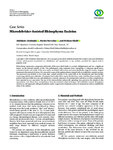Microdebrider-Assisted Rhinophyma Excision
| dc.contributor.author | Abushaala, A | |
| dc.contributor.author | Stavrakas, M | |
| dc.contributor.author | Khalil, Hisham | |
| dc.date.accessioned | 2019-12-05T16:52:55Z | |
| dc.date.available | 2019-12-05T16:52:55Z | |
| dc.date.issued | 2019-11-20 | |
| dc.identifier.issn | 2090-6765 | |
| dc.identifier.issn | 2090-6773 | |
| dc.identifier.uri | http://hdl.handle.net/10026.1/15224 | |
| dc.description.abstract |
<jats:p>Rhinophyma represents a progressive deformity of the nose which leads to cosmetic disfigurement and has a significant impact on the patient’s quality of life. This pathological entity originates from hyperplasia of sebaceous gland tissue, connective tissue, and vessels of the nose and is associated with rosacea and more specifically, stage III rosacea. Surgical treatment is the method of choice. We present five cases of rhinophyma that we treated with microdebrider-assisted excision. The procedure was divided in two main steps: scalpel excision of the main bulk of the rhinophyma and then further contouring with the microdebrider. All patients had weekly follow-up for the first four weeks, and then three-monthly. All patients had uneventful recovery and satisfactory cosmetic outcomes. No postoperative infections or other complications were reported in our case series. The use of the microdebrider reduces the operating time, preserves the islands of skin regeneration, and allows finer manipulations than the standard scalpel techniques. Microdebrider-assisted rhinophyma excision is a safe approach, with good aesthetic results. Larger series of patients need to be examined in order to establish the value of the method.</jats:p> | |
| dc.format.extent | 1-5 | |
| dc.format.medium | Electronic-eCollection | |
| dc.language | en | |
| dc.language.iso | en | |
| dc.publisher | Hindawi Limited | |
| dc.title | Microdebrider-Assisted Rhinophyma Excision | |
| dc.type | journal-article | |
| dc.type | Case Reports | |
| plymouth.author-url | https://www.ncbi.nlm.nih.gov/pubmed/31885991 | |
| plymouth.volume | 2019 | |
| plymouth.publication-status | Published | |
| plymouth.journal | Case Reports in Otolaryngology | |
| dc.identifier.doi | 10.1155/2019/4915416 | |
| plymouth.organisational-group | /Plymouth | |
| plymouth.organisational-group | /Plymouth/Faculty of Health | |
| plymouth.organisational-group | /Plymouth/Faculty of Health/Peninsula Medical School | |
| plymouth.organisational-group | /Plymouth/REF 2021 Researchers by UoA | |
| plymouth.organisational-group | /Plymouth/REF 2021 Researchers by UoA/UoA01 Clinical Medicine | |
| plymouth.organisational-group | /Plymouth/Users by role | |
| plymouth.organisational-group | /Plymouth/Users by role/Academics | |
| dc.publisher.place | United States | |
| dcterms.dateAccepted | 2019-11-02 | |
| dc.rights.embargodate | 2021-4-20 | |
| dc.identifier.eissn | 2090-6773 | |
| dc.rights.embargoperiod | Not known | |
| rioxxterms.versionofrecord | 10.1155/2019/4915416 | |
| rioxxterms.licenseref.uri | http://www.rioxx.net/licenses/all-rights-reserved | |
| rioxxterms.licenseref.startdate | 2019-11-20 | |
| rioxxterms.type | Journal Article/Review |


